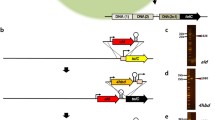Summary
A rapid and general procedure has been devised for the pBR322-mediated cloning in Escherichia coli of Bacillus subtilis chromosomal DNA extending in a specified direction from any Tn917 insertion. Derivatives of Tn917 have been constructed that contain a pBR322-derived replicon, together with a chloramphenicol-resistance (Cmr) gene of Gram-positive origin (selectable in B. subtilis), inserted by ligation in two orientations into a SalI restriction site located near the center of the transposon. When linearized plasmid DNA carrying such derivatives was used to transform to Cmr B. subtilis bacteria already containing a chromosomal insertion of Tn917, the pBR322 sequences efficiently became integrated into the chromosomal copy of the transposon by homologous recombination. It was then possible to clone chromosomal sequences adjacent to either transposon insertion junction into E. coli, using a selection for ampicillin-resistance, by transforming CaCl2-treated cells with small amounts of insert-containing DNA that had been digested with various restriction enzymes and then ligated at a dilute concentration. Because pBR322 sequences may be inserted by recombination in either orientation with respect to the transposon arms, a single restriction enzyme (such as EcoRi or SphI) that has a unique recognition site in pBR322 DNA may be used to separately clone chromosomal DNA extending in either direction from the site of any transposon insertion. A family of clones generated from the region of an insertional spo mutation (spoIIH::Tn917) was used in Southern hybridization experiments to verify that cloned material isolated with this procedure accurately reflected the arrangement of sequences present in the chromosome. Strategies are discussed for taking advantage of certain properties inherent in the structure of clones generated in this way to facilitate the identification and study of promoters of insertionally mutated genes.
Similar content being viewed by others
References
Bertani G (1951) Studies on lysogenesis I. The mode of phage liberation by lysogenic E. coli. J Bacteriol 62:293–300
Birnboim HC, Doly J (1979) A rapid alkaline extraction procedure for screening recombinant plasmid DNA. Nucl Acids Res 7:1513
Bolivar F, Rodriguez RL, Greene PJ, Betlach MC, Heyneker HL, Boyer HW, Crosa JH, Falkow S (1977) Construction and characterization of new cloning vehicles II. A multipurpose cloning system. Gene 2:95–113
Canosi U, Morelli G, Trautner TA (1978) The relationship between molecular structure and transformation efficiency of some S. aureus plasmids isolated from B. subtilis. Mol Gen Genet 166:259–267
Contente S, Dubnau D (1979a) Characterization of plasmid transformation in Bacillus subtilis: Kinetic properties and the effect of DNA conformation. Mol Gen Genet 167:251–258
Contente S, Dubnau D (1979b) Marker rescue transformation by linear plasmid DNA in Bacillus subtilis. Plasmid 2:555–571
Copeland JC, Marmur J (1968) Identification of conserved genetic functions in Bacillus by use of temperature-sensitive mutants. Bacteriol Rev 32:302–312
Dubnau D (1976) Genetic transformation in Bacillus subtilis: A review with emphasis on the recombination mechanism. In: Schlessinger D (ed) Microbiology-1976. Am Soc Microbiol, Washington DC, pp 14–27
Dubnau D, Davidoff-Abelson R (1971) Fate of transforming DNA following uptake by competent Bacillus subtilis I. Formation and properties of the donor-recipient complex. J Mol Biol 56:209–221
Dubnau D, Davidoff-Abelson R, Smith I (1969) Transformation and transduction in Bacillus subtilis: evidence for separate modes of recombinant formation. J Mol Biol 45:155–179
Horinouchi S, Weisblum B (1982) Nucleotide sequence and functional map of pC194, a plasmid that specifies inducible chloramphenicol resistance. J Bacteriol 150:815–825
Iordanescu S (1976) Three distinct plasmids originating in the same Staphylococcus aureus strain. Arch Roum Path Exp Microbiol 35:111–118
Kleckner N, Roth J, Botstein D (1977) Genetic engineering in vivo using translocatable drug-resistance elements. J Mol Biol 116:125–159
Lund T, Grosveld FG, Flayell RA (1982) Isolation of transforming DNA by cosmid rescue. Proc Natl Acad Sci USA 79:520–524
Mandel M, Higa A (1970) Calcium-dependent bacteriophage DNA infection. J Mol Biol 53:159–162
Meselson M, Yuan R (1968) DNA restriction enzyme from E. coli. Nature 217:1110–1114
Perucho M, Hanahan D, Lipsich L, Wigler M (1980) Isolation of the chicken thymidine kinase gene by plasmid rescue. Nature 285:207–210
Piggot PJ, Coote JG (1976) Genetic aspects of bacterial endospore formation. Bacteriol Rev 40:908–962
Rigby PWJ, Dieckmann M, Rhodes C, Berg P (1977) Labeling deoxyribonucleic acid to high specific activity in vitro by nicktranslation with DNA polymerase I. J Mol Biol 113:237–251
Roeder GS, Fink GR (1980) DNA rearrangements associated with a transposable element in yeast. Cell 21:239–249
Sharp PA, Sugden B, Sanbrook J (1973) Detection of two restriction endonuclease activities in Haemophilus parainfluenzae using analytical agarose-ethidium bromide electrophoresis. Biochemistry 12:3055–3063
Smith HO, Danner DB, Deich RA (1981) Genetic transformation. Annu Rev Biochem 50:41–68
Southern EM (1975) Detection of specific sequences among DNA fragments separated by gel electrophoresis. J Mol Biol 98:503–517
Tomich PK, An FY, Clewell DB (1980) Properties of erythromycin-inducible transposon Tn917 in Streptococcus faecalis. J Bacteriol 141:1366–1574
Weiss B, Jacquemin-Sablon A, Live TR, Fareed GC, Richardson CC (1968) Enzymatic breakage and joining of deoxyribonucleic acid. J Biol Chem 243:4543–4555
Youngman PJ, Perkins JB, Losick R (1983a) Genetic transposition and insertional mutagenesis in Bacillus subtilis with Streptococcus faecalis transposon Tn917. Proc Natl Acad Sci USA 80:2305–2309
Youngman PJ, Perkins JB, Sandman K (1983b) New genetic methods, molecular cloning strategies and gene fusion techniques for Bacillus subtilis which take advantage of Tn917 insertional mutagenesis. In: Hoch JA, Ganesan AT (eds) Genetics and biotechnology of Bacilli. Academic Press, New York, in press
Youngman PJ, Perkins JB, Losick R (1984) Construction of a cloning site near one end of Tn917 into which foreign DNA may be inserted without affecting transposition in Bacillus subtilis or expression of the transposon-borne erm gene Plasmid vol 11 (in press)
Author information
Authors and Affiliations
Additional information
Communicated by G.R. Fink
Rights and permissions
About this article
Cite this article
Youngman, P., Perkins, J.B. & Losick, R. A novel method for the rapid cloning in Escherichia coli of Bacillus subtilis chromosomal DNA adjacent to Tn917 insertions. Mol Gen Genet 195, 424–433 (1984). https://doi.org/10.1007/BF00341443
Received:
Issue Date:
DOI: https://doi.org/10.1007/BF00341443




